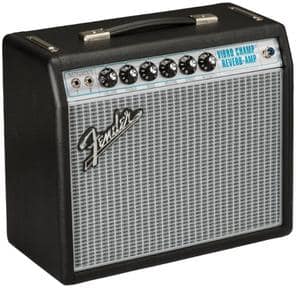
Are you looking for big Fender mojo in a little package? In this Fender 68 Custom Vibro Champ Reverb review, I’ll tell you why this small amp can kick some serious sonic butt!
Meet the Vibro Champ that adds reverb and more bass for a big sound that can cover everything from rock and traditional blues to jazz.
Keep on reading to get up to speed on the newest edition of Fender’s ’68 Custom amp series!
What Is The 68 Custom Vibro Champ Reverb?
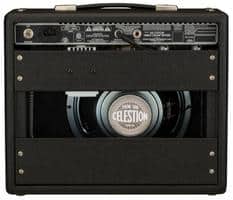
The 68 Custom Vibro Champ Reverb is part of Fender’s ’68 Custom amp series. This series retains the classic look and sound of the original amps while adding modifications that improve the overall tone.
It takes the original 5 Watt 68 Vibro Champ to the next level by adding a lush Hall reverb and upgrading the speaker size to 10 inches to beef up the amp’s low-end.
The rest of the amp is true to the original ’68 Vibro Champ spec.
68 Custom Vibro Champ Reverb – Cheat Sheet
⭐️ ⭐️ ⭐️ ⭐️ ⭐️ ⭐️ ⭐️ ⭐️ ⭐️ ☆ 8.8 Out Of 10
A 5 Watt Redesign Of The Vibro Champ That Features A Digital Reverb And A larger 10 Inch Speaker.
If you want to go directly to the Vibro Champ Reverb specs then click here.
PROS
✅ Great Sound
✅ Enhanced Low End
✅ Wide-Range Vibrato
CONS
❌ Footswitch Not Included
❌ No effects Loop
❌ Reverb Is Digital
Design
⭐️⭐️⭐️⭐️⭐️⭐️⭐️⭐️☆☆
8.0 Out Of 10
Overall Quality
⭐️⭐️⭐️⭐️⭐️⭐️⭐️⭐️⭐️☆
9.0 Out Of 10
Functionality
⭐️⭐️⭐️⭐️⭐️⭐️⭐️⭐️⭐️☆
9.0 Out Of 10
Price
⭐️⭐️⭐️⭐️⭐️⭐️⭐️⭐️⭐️☆
9.0 Out Of 10

Fender Company Profile
Unless you just started playing the guitar today, you are undoubtedly familiar with the Fender brand. These guitars have literally helped define rock n’ roll and blues history. Their original factory was in Fullerton California.
Fender guitars are now made in many parts of the world, with the American-made and Custom Shop guitar lines still made with pride in the USA.
The Fender Broadcaster was first introduced in the autumn of 1950. It became known as a “Nocaster” after the Broadcaster label was removed from the headstock to avoid a trademark lawsuit from Gretsch over their “Broadkaster” drum set. The guitar was re-branded the Telecaster, and the rest is history!
Fender has also led the way with amplifiers. Their “K&F” (Doc Kauffman and Leo Fender) series were the very first Fender amps, made by the K&F Manufacturing Corporation. These amps formed the basis of the Woodie, Tweed, Blonde, Brownface, Blackface, and Silverface series.
Who Is The 68 Custom Vibro Champ Reverb For?
This amp is for anyone that wants the Champ’s unique tube sparkle and low-volume breakup, with a re-design that overcomes its speaker size limitations. If you’ve ever played through a Champ, you know what I’m talking about. It shines in the upper and midrange registers but can be a little shallow at the bottom.
Despite its limitations, no matter how I adjust my other Fender amps, they never quite sound and perform like a Champ. This is what made this “student” amp attractive to professional players for recording and playing smaller gigs.
The 68 Custom Vibro Champ Reverb is the perfect amp for players that like clean to mildly overdriven sounds at bedroom-friendly levels.
How The Vibro Champ Reverb Amp Works
The Vibro Champ Reverb Amp’s operation is straightforward and identical to the vintage Vibro Champ, except for the addition of the reverb adjustment knob and a reverb button on the footswitch.

Here are the specifications for the 68 Custom Vibro Champ Reverb.
| Item | Specification |
|---|---|
| Power | 5 Watts RMS |
| Channels | One Channel |
| Equalization Controls | Treble and Bass |
| Preamp Valves (Tubes) | Two ECC83 (12AX7) |
| Power Amp Valve | One 6V6GT |
| Inputs | 2 x 1/4″ instrument jacks |
| Effects | Vibrato and Digital “Hall” Reverb |
| Effects Loop | No |
| Line Outs (on back of amp) | 1 x 1/4″ (internal speaker), 1 x 1/4″ |
| Footswitch | Yes (reverb, tremolo), Not Included |
| Speaker | 1 x 10″ Celestion Ten 30 G10R-30 (ceramic magnet) |
| Cabinet | 7-ply Birch Plywood with Silver Turquoise Grille Cloth |
| Covering | Black Textured Vinyl |
| Handle | Black Molded Plastic Strap with Silver Caps |
| Dimensions | H: 14″, W: 16.88″, D: 8.12″ |
| Weight | 20.4 lbs |
| Price | $800 (Street) |
68 Custom Vibro Champ Reverb VS Vintage 68 Vibro Champ
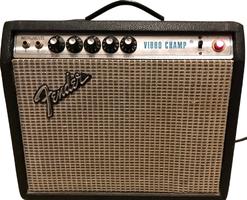
’73 Vibro Champ
So, what’s the difference between a 68 Custom Vibro Champ Reverb and a vintage 68 Vibro Champ besides overall sound, collectability, and cost?
Surprisingly, there is not a major price difference between the two amps, unless the vintage model is mint & in perfect working condition with all original parts.
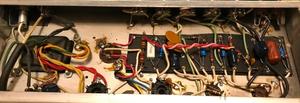
’68 Silverface Vibro Champ
Check out this comparison chart, which shows the major differences between the two amps.
| Item | 68 Custom Vibro Champ Reverb | Vintage 68 Vibro Champ |
|---|---|---|
| Circuit Design | Modern-Style PCB | Point-To-Point Handwired (AA764) |
| Tube-Driven Vibrato | Yes | Yes |
| Reverb | Yes (DSP “Hall”) | No |
| Footswitch | Reverb and Vibrato | Vibrato |
| Speaker | 1 x 10″ Celestion Ten 30 G10R-30 | 1 x 8″ Oxford 8EV |
| Power | 5 Watts RMS | 6 Watts RMS |
| Rectifier | Solid State | Tube (5Y3) |
| Preamp Valves | Two ECC83 (12AX7) Tubes | Two 7025 (low-noise, low-hum 12AX7) |
| Amp Valve | One 6V6GT | One 6V6GT |
| Amp Configuration | Single-Ended Class A | Single-Ended Class A |
| Schumacher Transformer? | Yes | Yes |
| Manufactured In: | Mexico | USA |
| Price | $800 (Street) | 750 – $1,000 & up (good condition) |

Features And Benefits
Here are some of the features and benefits of the 68 Custom Vibro Champ Reverb.
Solid Cabinet Design
The 68 Custom Vibro Champ Reverb has a robust 7-ply Birch Plywood cabinet covered with Black Textured Vinyl that helps project the sound and keep vibration to a minimum, especially with the oversized 10-inch speaker.
The cabinet comes with a period-correct Silver Turquoise Grille Cloth that looks great with the front control panel.
Class-A Tube Design
The amp has an all-tube Class-A design that is fairly quiet even at near-saturated levels. It has a solid-state rectifier that gives it less power sag than the vintage Silverface Vibro Champ.
Lush “Hall” Reverb
The Vibro Champ Reverb comes with a lush digital (DSP) Hall reverb that performs well, even at higher settings, without sounding too harsh or artificial. It can make your playing sound three-dimensional without overpowering the music, even in larger rooms.
Takes Pedals Well
With a relatively low noise floor, this Champ takes overdrive, distortion, and fuzz pedals well. Echo and modulation pedals like phaser, flanger, and chorus sound good, even though there is no effects loop available.
Compact And Lightweight
At just over 20 pounds, the size and weight of the ’68 Custom Vibro Champ Reverb make it a pleasure to carry around, and it can fit in the tightest spaces. It’s a real “back-saver,” especially if you frequently tote it to band practice.
Good Price Point
The Vibro Reverb Champ is reasonably priced for the quality of the build and overall performance. You really get a lot for your money, especially for a tube amp.

What I Like About It
Here are the things that make the ’68 Custom Vibro Champ Reverb a serious contender in the small combo amp arena.
Dynamic Response
This amp is very responsive to picking dynamics and fingerboard gymnastics like hammer-ons and trills. Using a single-coil guitar, like a Tele, gives the amp plenty of champ-like “zing.” Humbucker-guitars will provide you with a bit more of a “darker” sound.
Clean Break-Up
As you crank the volume above 5, you will begin the notice the amp subtly saturate in a very musically usable way. Depending on the guitar, the amp will start to break up nicely around or above a volume of 8.
If you’re looking for the clean “Fender” naturally overdriven sound, this amp will give it to you without a pedal.
Enhanced Low-End
The 10 inch Celestion Ten 30 G10R-30 speaker adds a lot of tight-sounding low end for an amp in this size and power category. Chords sound rich and full without suffocating the mids, while solos sound well-balanced
Wide-Range Vibrato
The Champ’s vibrato can easily conjure the ’50s surf sound or ’60s “psychedelic” textures. It has an overall silky smooth character that can add enticing subtly to jazz comping.

What You Might Not Like About It
No effects loop
An effects loop would have really added a lot of functionality to this amp.
Time-based pedals, like echo, always sound and perform better when placed in an effects loop between the preamp and amp section, especially when combined with overdrive, distortion, or fuzz pedals in the front-end.
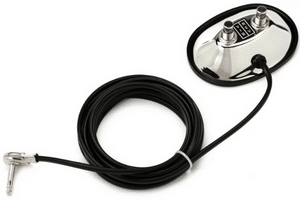
Footswitch Not Included
If you want to quickly and easily engage the amp’s vibrato and reverb, you need to buy a footswitch to plug into the rear of the unit.
A Fender 2-button vibrato/reverb footswitch will cost you an extra $37, on average. Unfortunately, if you use reverb or vibrato frequently, this switch is a “must-have.”
Digital Reverb
A tube-driven reverb would have been more suitable for the sound of this amp, although it’s a little too much to ask for the price of this unit.
The DSP reverb, as stated above, is very usable. The HALL configuration will bring your playing out front in the mix, even when set at low settings.

Beware Of These Issues
Not A Giggable Amp
The ’68 Custom Vibro Champ Reverb is ideally suited as a “practice amp,” which is what the original Vibro Champ was designed for.
If you’re a beginner or looking for great Fender sound at bedroom levels, this unit is a perfect choice.
It can get you through band practice without an overly aggressive drummer or a small club performance with a quiet audience but be prepared to mic it into the mixing board for anything larger.
Amp Cover Not Included
As far as I know, Fender does not make an amp cover specifically for this amp. You could give the Fender Champ 110 cover (H: 14″, W: 18″, D: 8.″) a try, which might be a little loose in width and snug in depth.
If you’re buying the amp for home use, you really don’t need a cover, but if you’re planning on gigging with it, you might seriously consider something to protect it from road wear.
No “Middle” Tone Control
The tone stack in this amp does not include a “middle” adjustment, but to be fair, the original Champ and Vibro Champ amps never had one. Traditionally, the smaller amps did not have a middle tone control, although some of the newer boutique low-watt amps are made with one.
The lack of a middle tone knob is one of the things that gives this amp its typical sound.
Is The 68 Custom Vibro Champ Reverb Legit?
This amplifier is an excellent option if you’re looking for the Fender “Vibro Champ” sound with an augmented low end and built-in reverb. It won’t quite stack up against a vintage ’68 Vibro Champ in terms of purity of tone, but this amp is the most practical alternative.
If you want to pay more for the real thing, then vintage Vibro Champs are fairly easy to locate, but I would rather go with this ’68 reissue model and take advantage of the updated design and performance reliability.

Frequently Asked Questions
Where Is The Fender 68 Custom Vibro Champ Reverb Made?
This amp is made in one of Fender’s factories in Mexico. These products are typically very high quality for the money. I have many made-in-Mexico (MIM) guitars and amps that really rock!
Is There A Power Output Difference Between The Reissue Vibro Champ Reverb And The Vintage Vibro Champ?
There is technically a one-Watt Difference. The reissue amp is rated a 5 Watts RMS, and the vintage Vibro Champ is rated at 6 Watts RMS.
Despite the power output difference, both amps are approximately the same in terms of overall loudness. The reissue amp can actually be a little louder due to the 10-inch speaker size and less power sag from the solid-state rectifier.
Was There A Vintage ’50s Tweed Version Of The Fender Vibro Champ?
No, Fender introduced the first Vibro Champ amp in 1964 and discontinued it in1982. The Vibro Champ was used to design the Fender Bronco amplifier in 1967.
The Vibro Champ and Bronco were essentially the same, except for a change in aesthetic features, like a change in the look of the Fender decal. The Bronco amp had a matching single-pickup Bronco guitar. They were both aimed at beginning guitar students.
History Of The Fender Champ Amplifier
Here is a brief history of the first Fender Champ amp and its evolution over the years.
Fender Champion 800/600 (1948)
Introduced in 1948, this was the very first amp of the series. The Champion 800 had an 8-inch speaker, while the Champion 600 sported a 6-inch speaker.
Rated at about 3 Watts, both amps had a single 6SJ7 pentode in the preamp section and one 6V6 tetrode in the power amp section, along with a 5Y3 rectifier tube. There was a single-volume knob with no tone control.
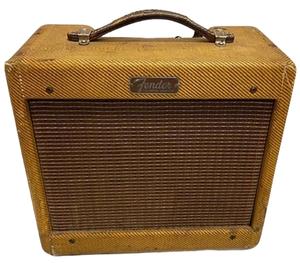
Fender Tweed Champ (1955)
This amp was built into a new “Narrow Panel” tweed cabinet with an oxblood color grill cloth. It was available in both the 6 and 8-inch speaker configurations.
It had a 12AX7 dual-triode preamp and a single 6V6GT power tube to produce 5 watts of power.
Fender Blackface Champ (1964)
In 1964 fender updated the amp’s circuit and cabinet to the blackface design. This marked the beginning of the black panel and black Tolex cabinet covering.
Fender Vibro Champ (1964)
The Vibro Champ added a vibrato circuit and was available in blackface and silverface versions. It had speed and intensity controls. It was discontinued in 1982. The silverface version was used to design the Fender Bronco amplifier in 1967.
Fender Silverface Champ (1968)
Fender updated the circuit and cabinet to the silverface design, which featured a new silver control panel with silver turquoise grille cloth.
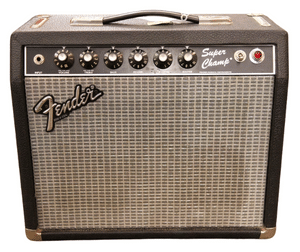
Fender Super Champ (1982)
This was essentially a Champ on steroids with a Class A/B (push-pull) amplifier, a master volume, a 10″ speaker, and spring reverb. This higher-powered amp had a volume and midrange boost and produced 18 Watts RMS.
Fender Champ II (1982)
The Champ II was essentially an 18 Watt lower-gain version of the Super Champ, without the volume and midrange boost. It also had no reverb. This amp was discontinued after three years due to lackluster sales.
Fender Champion 600 Reissue (2006)
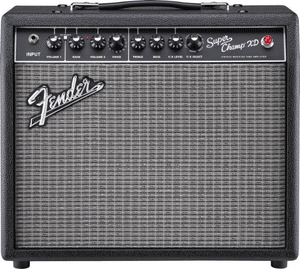
This amp was a Champion 600 reissue with a modified blackface Champ circuit.
Fender Super Champ XD (2007)
This amp was a reissue of the Super Champ. It was a hybrid design that used tube circuitry with digital modeling and effects, including reverb, delay, chorus, and tremolo.
Fender Vibro Champ XD (2007)
The Vibro Champ XD was a resurrected Vibro Champ that used a hybrid design to couple tube circuitry with a digital modeling processor to produce reverb, delay, chorus, tremolo, and Vibratone.
Fender ’57 Champ (2009)
The Fender ’57 Champ was simply a reissue of the 1957 narrow panel tweed Champ.
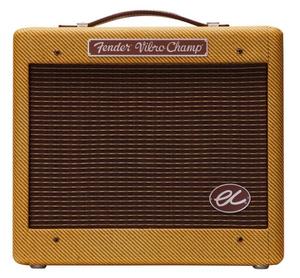
Vibro Champ
Fender Eric Clapton Signature Vibro Champ (2013)
This amp is based on the original Vibro Champ, built in a tweed cabinet. It has an 8-inch Weber speaker with volume and vibrato controls.
The design also incorporates a custom-made Schumacher transformer.
Fender ’68 Custom Vibro Champ Reverb (2021)
This 5 Watt amp is the main subject of this article. It was introduced in January 2021 as a part of their Vintage Modified series. It is similar to the Vibro Champ with the addition of a digital Hall reverb and a larger 10-inch speaker.

Final Thoughts On The Fender 68 Custom Vibro Champ Reverb Review
The 68 reissue Vibro Champ is Fender’s attempt to take their original amp to the next level with the addition of a Hall reverb and a larger 10-inch speaker. It is part of the ’68 Custom Amp series.
Adding a Hall reverb gives the amp a larger and more three-dimensional sound. The 10-inch speaker makes it more robust in the low-end without being flabby-sounding.
If you are looking for an option that takes the Fender “Champ” sound to the next level, this reimagined tube amp is definitely worth a look. It can give you the best of both worlds between a compact combo and something that sounds a little bigger.
The 68 Custom Vibro Champ is an excellent choice for bedroom and band practice at low levels. At 5 Watts, it begs to be cranked and rewards you with a warm break-up that can be perfectly dialed in with your guitar’s volume knob.
You will not want to gig with this amp without micing it into the mixing board.
For another great amp, see Fender Tone Master Review – Check Out The New Super Reverb!
Also see, Fender 65 Princeton Reverb Review: Top-Notch All-Tube Tone!
For more info on combo tube amps Click Here –>Best Combo Guitar Amps For Any Budget: 5 All-Tube Beauties!

Tell Me What You Think
Please leave a comment below if you enjoyed this Fender 68 Custom Vibro Champ review, have any questions about this product, or want to leave your own review.
I will be happy to help you.
- Do you own a ’68 Custom Vibro Champ? What do you think of it?
- How do you think this amp compares to the 1964 vintage Vibro Champ?
- After reading this review, would you buy this amp?


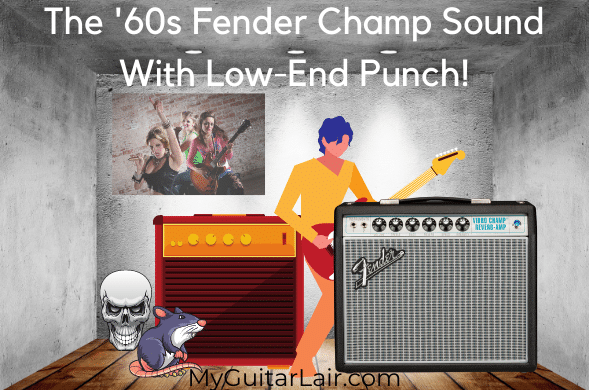


I come from a family of musicians so I know you can’t do a gig without a good amp. And Fender is the best of the best, an industry icon. Due to its high quality and stellar reputation, it’s a no-brainer that this particular practice amp has been going strong for almost 75 years. It’s too bad we can’t get it in “vintage” tweed but what are you gonna do? I wish you had included a link for purchasing this great product!
Hi, Cynthia
Thank You for your comments!
You seem to know a little about guitar amplifiers. Do you play? If not, there’s no time to start like the present, regardless of how old you are!
Fender doesn’t make a ’50 tweed version of the Vibro Champ with reverb and a 10-inch speaker, but if they did, it would likely have a different circuit design, to match that time period.
If anyone you know is looking for a great Champ, you/they should give the Fender Eric Clapton Signature Vibro Champ a look. Check it out in my article. It has an 8 Weber inch speaker, ’50s circuitry, and a single volume and vibrato control (no tone control). It is pricey, but it’s an amp to die for!
The EC Vibro Champ can be a hard amp to find, but there’s also the Fender ’57 Custom Champ 1×8 Tube Combo Amp (5-Watts), which I own, and it is a little beast that puts out fabulous sounds! You can get this amp on Sweetwater dot com, and Amazon also has them now and again.
Happy Holidays!
Frank
Wow, this article packs some serious punch! Almost as much as the product it promotes!
You have not missed a thing, which I really appreciate, as it is so important to know all the facts before purchasing any new audio equipment.
I especially like that you include information on what a new purchaser may not like about the fender amp. I do not think the downsides to this amp are that big of a deal. Not having a footswitch is not that big of a deal when you are getting such a compact machine that sounds so good
The history of the fender amps is very interesting as well. I specifically like that Fender has kept the design integrity consistent throughout the years.
With Fender you just know the quality is going to be exceptional. Some may be nervous to purchase a product made in Mexico, but Fender is such a reliable brand that I just would not have the same apprehension I would with other products.
Thanks again for the great information. This really helped me decide whether or not I should make this purchase!
Hi, Ashley
Thank You for your comments!
You really can’t go wrong with this amp if your looking for the Fender sound in a low-power combo for practice or playing very small venues that don’t require a lot of power.
I own a few different Fender Champ models, and they all have unique sound and performance profiles. The ’50s (Tweed), ’60s (Blackface), and ’70s (Silverface) models are all excellent, each in their way.
If you decide to buy the amp, I would invest the extra money to buy the vibrato/reverb footswitch. You’ll be pleased you did!
Please come back and visit my site soon!
Happy Holidays,
Frank
Great article.
If you were to uppgrade the speaker on the 2021 68 Vibro Champ, wich loudspeaker would you choose?
Possible to get a richer sound at low volume by uppgrading, or more headroom?
Andreas
Hi, Andreas
Thank You for your questions!
I think the 68 Custom Vibro Champ Reverb sounds excellent with the 10-inch Celestion G10R-30 that comes with the amp. If you are looking for more of a late’50s to early ’60s sound, then your might like the sound of the Weber 10A125. It has a bit of a tighter low-end at a low volume and gives you a fat compressed sound when you push the amp.
You’re not going to get a tremendous amount of headroom out of a 5 Watt RMS Champ. Driving the front end with a pedal might be your answer.
It really comes down to personal sound preference. You may have to experiment with a few different speakers until you find what you like.
Happy New Year! Have a great 2022!!
Frank
You’ve provided a lot of info about this amp. Thanks for that. The amp sounds great on the YouTube vids. But I don’t recall anyone saying it was quiet. I pulled the trigger and the vibro champ is very quiet. Question. How r the mids controlled with no EQ knob?
Hi, Kathi
Thank You for your inquiry!
Congrats on buying the amp!! So thrilled you like it!
In this kind of tone-stack setup, the mids are indirectly controlled by adjusting the treble and bass up or down. So, adjusting the treble knob will raise or lower the high-frequency spectrum but will also change the high-end of the mids. Likewise, adjusting the bass knob will raise or lower the low-frequency spectrum but will also change the low-end of the mids.
This type of circuit design is what gives the amp its classic sound.
You can always get a graphic equalizer pedal if you want more control over the mids.
Enjoy your new amp!
Frank
Fender needs to sell a cover for this. Mine does not have a cover.
Hi, John
Thank You for your comment!
The cover that Fender sells separately is the: Fender Multi-fit Cover for Champ 110, XD Series, and G-Dec 30.
It has the following dimensions: H 15.5″ W 17″ D 8.25″
Your amp dimensions are: H 14″. W 16.88″. D 8.25″ So, it will be a little big, height-wise
Here is Fender’s cover description:
https://www.fender.com/en-US/parts/amp-covers/multi-fit-amplifier-cover—champ-110-xd-series-g-dec-30/0041529000.html
Sweetwater sells it:
https://www.sweetwater.com/store/detail/SuperChXDcvr–fender-multi-fit-cover-for-champ-110-xd-series-and-g-dec-30?utm_source=google&utm_medium=organicpla&mrkgadid=3311211046&mrkgcl=28&mrkgen=gpla&mrkgbflag=0&mrkgcat=guitars&acctid=21700000001645388&dskeywordid=92700067097732137&lid=92700067097732137&ds_s_kwgid=58700007462844864&ds_s_inventory_feed_id=97700000007215323&dsproductgroupid=523574030391&product_id=SuperChXDcvr&prodctry=US&prodlang=en&channel=online&storeid=&device=c&network=g&matchtype=&adpos=largenumber&locationid=9002188&creative=555205126216&targetid=pla-523574030391&campaignid=15034343265&awsearchcpc=1&gclid=CjwKCAjwrqqSBhBbEiwAlQeqGvaOW3UAb9tpJpC-jzktD3lB8XiMjtW9XeDm3rjEezq3CEIxUH38jxoC1uQQAvD_BwE&gclsrc=aw.ds
Here are a few options to solve your problem:
1. Buy this amp cover and take it to a local seamstress to have it shortened in height. I’ve done this before.
2. Buy a custom-made cover. Here’s one place: https://www.amplifiercovers.com/shop-all/fender/fender-68-custom-vibro-champ-1×10-combo-cover/
Unfortunately, Fender has a long tradition of selling their amp covers separately. Even when I bought my first Fender amp back in the late 1960’s I had to buy the covers.
Hope this helps,
Frank
Frank,
Could you confirm whether or not the Celestion speakers in this amp have alnico or ceramic
magnets. I am guessing they are alnico.
Thanks
Stan
Hi, Stan
The Celestion Ten 30 speaker in the Fender 68 Custom Vibro Champ Reverb has a ceramic magnet. You can read about it here:
https://celestion.com/product/ten-30/
Let me know if you have any other questions.?
Rock On!?
Frank ?